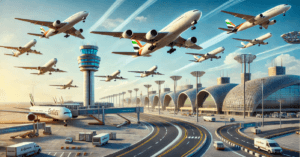India-UAE Airfares May Drop 20% as Flight Capacity Doubles in Five Years
Airfares between India and the UAE could drop by 20% in the next five years as flight capacity doubles. UAE Ambassador Abdulnasser Jamal Alshaali stated that this could save Indian travelers around $1 billion. The UAE has proposed a phased 4:1 flight ratio, where Indian airlines get four additional flights for every one granted to UAE carriers. This ratio will gradually reduce to 1:1 as Indian airlines expand. The plan aims to boost competition, lower prices, and improve connectivity to tier-2 and tier-3 cities. Increased connectivity is expected to boost tourism and consumer spending.
Indian carriers will also benefit from reduced pressure on domestic routes. Beyond aviation, India and the UAE are strengthening ties in defense, technology, and trade. Bilateral trade has exceeded $80 billion with a 15% growth rate. The UAE is also collaborating with India on petroleum reserves and emerging sectors like genome sequencing and data centers.

India-UAE Airfares May Drop 20% as Flight Capacity Doubles in Five Years
Air travel between India and the UAE is expected to become more affordable in the coming years, with fares potentially dropping by up to 20% on certain routes over the next five years. This reduction is likely due to a planned increase in flight capacity between the two countries. UAE Ambassador to India, Abdulnasser Jamal Alshaali, told CNBC-TV18 that if the number of flights doubles, Indian travelers could collectively save around $1 billion.
To achieve this, the UAE has proposed a phased approach to expanding flight connectivity. Initially, a 4:1 ratio has been suggested, meaning that for every new flight or additional seat capacity granted to UAE airlines, Indian airlines would receive four. As Indian carriers grow their operations, this ratio would gradually adjust to 3:1, then 2:1, and eventually reach 1:1. This approach aims to support the growth of Indian airlines while maintaining a competitive aviation market.
The primary goal of this initiative is to enhance competition, reduce airfare costs, and improve connectivity, particularly to tier-2 and tier-3 cities beyond major metropolitan areas. Ambassador Alshaali emphasized that increased connectivity would not only boost tourism but also drive consumer spending. Additionally, it would ease the operational burden on Indian airlines, which currently handle most domestic air traffic.
Beyond aviation, India and the UAE continue to strengthen their ties in key sectors such as defense, technology, and trade. Bilateral trade between the two nations has already surpassed $80 billion, growing at an impressive rate of 15%. The UAE is also collaborating with India on strategic projects, including petroleum reserves, and exploring partnerships in advanced fields such as genome sequencing and data centers.
In summary, the planned expansion of flight capacity between India and the UAE is set to make air travel more affordable and accessible. By implementing a gradual approach, both countries aim to create a balanced and competitive aviation market. This initiative is part of a broader effort to deepen bilateral ties, benefiting not only the aviation sector but also fostering growth in tourism, trade, and technology.
As these efforts advance, travelers can expect more options, lower costs, and improved connectivity between the two nations. This will also lead to increased business opportunities, stronger cultural exchanges, and easier access to emerging destinations. With enhanced infrastructure and more efficient flight operations, passengers will benefit from better services, reduced travel times, and a seamless flying experience. Additionally, improved airline competition could lead to better in-flight amenities and promotional offers, further enhancing affordability. The initiative will not only support tourism and economic growth but also create job opportunities in both countries, strengthening their long-term partnership across multiple industries.
You must be logged in to post a comment.